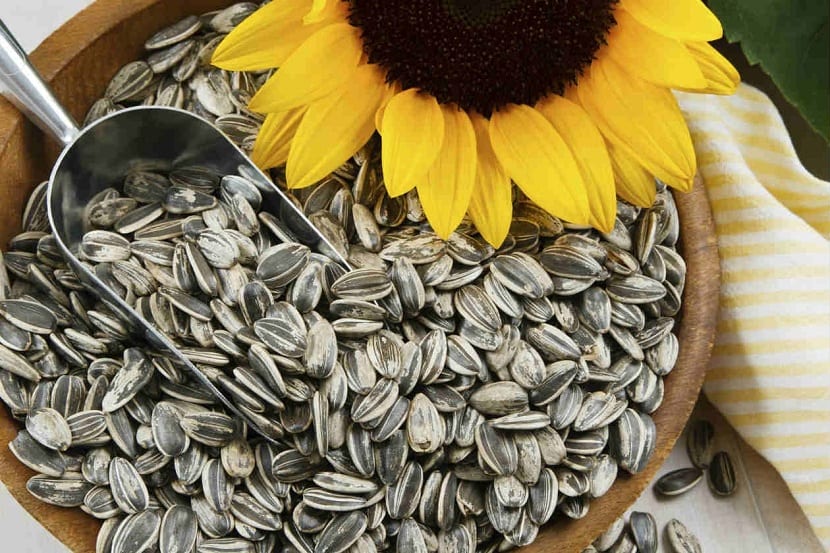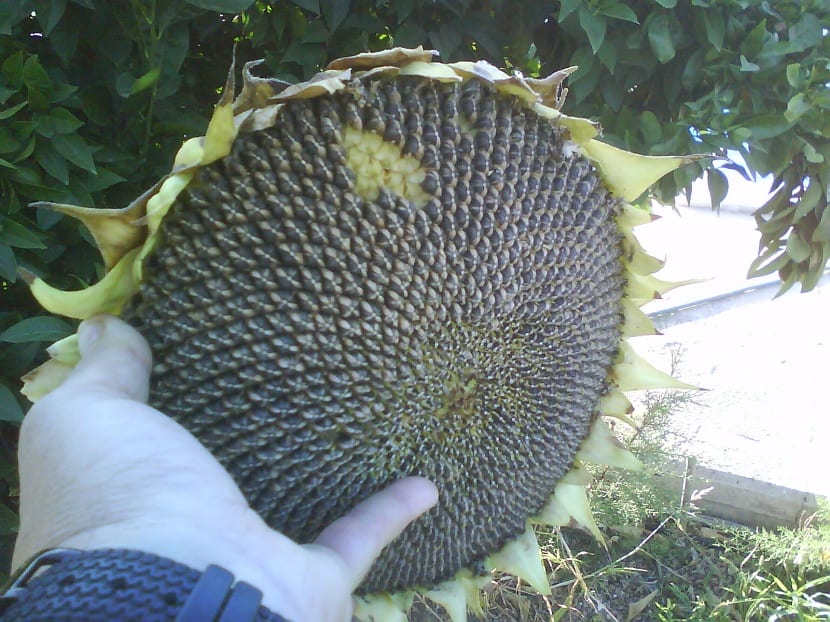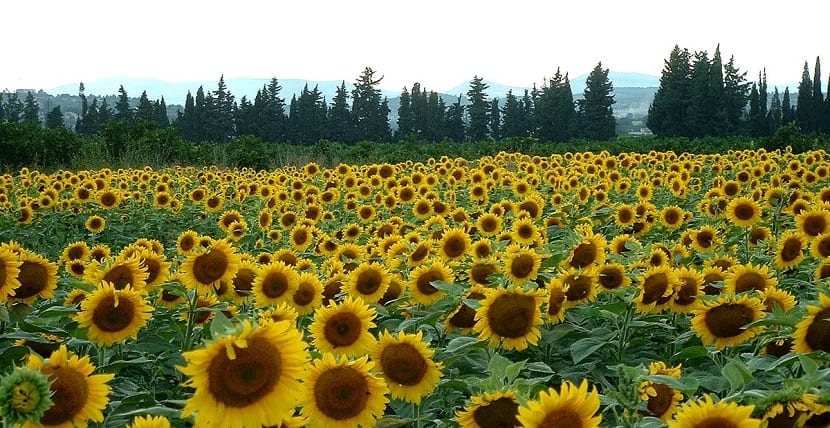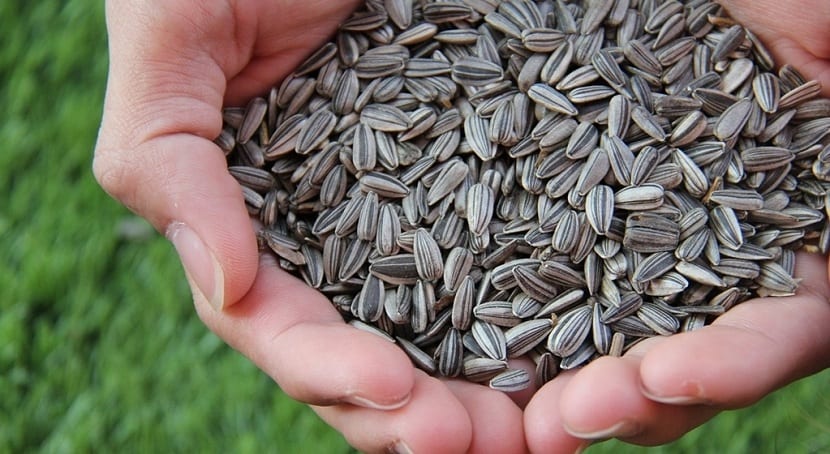
Today we are going to talk about one of the most consumed nuts in the world. It's about the sunflower seeds. The sunflower is a plant from America and was discovered around 1000 BC. The Spanish introduced the sunflower to Europe at the beginning of the XNUMXth century. It is a well-known and commercialized crop throughout the world, since sunflower seeds have beneficial properties.
In this post you will be able to know everything you need to know about sunflower cultivation, the properties of pipes and their main characteristics.
Sunflower characteristics

To know the properties of sunflower seeds, we first have to know the plant that produces it. The sunflower is an annual plant whose height is usually up to 3 meters. The stem is straight and cylindrical in shape. The leaves are elongated and velvety of about 50 centimeters long and 30 wide. They are very famous for being able to "follow" the sun. Its golden yellow color resembles that of the daisy, but large.
During the summer months they open and follow the orientation of the sun. Inside the flower you can see some small flowers forming a disk. It is these tiny flowers that will bear the edible fruit known as sunflower seeds. Depending on the variety of each plant, they can acquire one color or another.
How to grow

To grow sunflowers you need a fairly large space, since the plant reaches a lot of height. It can be planted both in orchards and gardens. Apart from to collect the sunflower seeds as fruit, They also serve for decoration thanks to their great color. If you have a small garden at home, it is advisable to choose those smaller varieties to achieve healthier growth.
Sunflower seeds should be sown in the spring months. Higher temperatures contribute to its better development. This plant does not withstand cold or cloudy days well. As their name suggests, they require many hours of sun. Sowing can be done in a large pot or directly in the ground. It is advisable to mix the substrate with vermiculite to enhance drainage and nutrient retention capacity.
Once we have sown the seeds, it is necessary to water abundantly and keep the soil moist so that they germinate correctly. If it has been planted in a pot, the watering must be monitored more constantly. They usually sprout in about three weeks.
Place and form of cultivation

To choose the place where you are going to plant the sunflower, you have to look at at least have 6 hours of direct sun up to date. In addition, if it is going to be sown in the ground directly, it is better to leave a separation between plant and plant of 20 centimeters. This will help them better share the nutrients in the growing medium and water.
Sunflowers are planted in rows 70 centimeters apart. When it comes to fertilizing them, the plant is quite grateful for those rich in nitrogen. When they reach maturity they are oriented to the east, to be able to collect as much sun as possible throughout the day.
Sunflower is perfect for urban gardens, since children can be involved in caring for them. In general, they are very attractive and easy-to-care crops and children love their fruit.
Sunflower seeds properties

Sunflower seeds are a good food that contains multiple health benefits. Among its properties we find:
- Has a high in vitamin E. 76% of the recommended daily amount of this vitamin can be covered with sunflower seeds. Also, it is a good antioxidant for eye health. It is the dried fruit with the highest content of this vitamin.
- It serves to fight stress and anxiety, since they have thianine and cysteine. They are also recommended for patients with parkinson's, multiple sclerosis, dementias and Alzheimer's.
- Lowers the risk of cancer.
- It contains a high content of vitamin of group B, this is found in American pipes in great quantity. They are used as a revitalizing and anti aging complex.
Plagues and diseases

Like almost all plants, the sunflower can also be affected by pests and diseases. Good planning is essential to avoid these types of situations and obtain good productivity. The sunflower crop has multiple uses and must be protected to obtain all the benefits.
Although it does not present serious phytosanitary problems, there are pathological risks that can destroy crops and lose it. Some insects on the ground usually cause serious losses in these plants. These are white and gray wireworms.
They are also affected by some larvae of butterflies, sucking insects or the well-known whitefly. These insects are pests that appear in isolation, but if they are not controlled correctly, they will affect more crops.
To treat sunflower it is important sanitize the entire affected area and not just the plant. This is done so that it does not harm the seeds or other plants.
Among the most important diseases that we can find in sunflower we have:
- Wet rot. It is recognized because they appear in environments of humidity and warm temperature. They affect the stem and destroy the vessels that carry the sage. When not being able to feed itself the sunflower dies.
- Verticillosis. It is a disease that affects from the base of the stem. It causes necrosis in stems and leaves. Sunflower seeds will not be suitable for consumption.
- Stalk canker. It appears the moment it produces the seeds. V-shaped spots can be seen on the leaves. It is produced by excessive fertilization outside the sowing seasons.
- Sunflower mildew. This disease causes dwarfism in plants. Its color is affected and its growth is much slower than normal. As the growth of the mildew progresses, the spores grow and form cottony structures.
Sunflower seeds are a product marketed in the world. However, it has problems like these behind it.